| Solution | You can connect your camera to a "  PictBridge" compatible printer to make direct prints. The direct printing procedure can be performed entirely with the camera while you look at the LCD monitor. NOTE  : PictBridge/<  >: Handheld Night Scene /<  >: HDR Backlight Control /  : RAW /<  >: Setting button / <  >: Playback button /<  >: Cross keys *The icons and markings indicating the cameras buttons, dials, and settings correspond to the icons and markings on the camera and on the LCD monitor. - You can also print
 images taken with this camera. images taken with this camera. - If you use a battery pack to power the camera, make sure it is fully charged. With a fully-charged battery, printing up to approx. 3 hr. 30 min is possible.
- Before disconnecting the cable, first turn off the camera and printer. Hold the plug (not the cord) to pull out the cable.
- For direct printing, using AC Adapter Kit ACK-E15(sold separately) to power the camera is recommended.
IMPORTANT - Before using the printer, make sure it has a PictBridge connection port.
- Movies cannot be printed.
- The camera cannot be used with printers compatible only with CP Direct or Bubble Jet Direct.
- Do not use any interface cable other than the one provided.
- Printing is not possible when shooting mode is set to <
 > or < > or < > in the <SCN> mode, or when Multi Shot Noise Reduction is set. > in the <SCN> mode, or when Multi Shot Noise Reduction is set.
1. Set the cameras power switch to <OFF>. 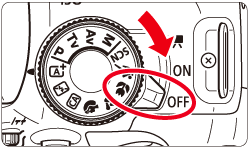 2. Set up the printer. For details, see the printers instruction manual. 3. Connect the camera to the printer. - Use the interface cable provided with the camera.
- Connect the cable to the cameras <DIGITAL> terminal with the cable plugs <
 > icon facing the front of the camera. > icon facing the front of the camera. - To connect to the printer, refer to the printers instruction manual.
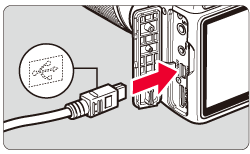 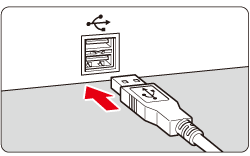 4. Turn on the printer. 5. Set the cameras power switch to <ON>. Some printers may make a beeping sound. 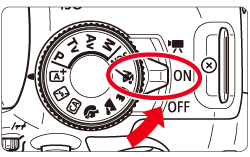 CAUTION - If there is a long beeping sound, it indicates a problem with the printer. A message like the ones shown in the table below will appear on the camera's LCD monitor. Press <
 > to stop printing, and then resume printing after fixing the problem. > to stop printing, and then resume printing after fixing the problem. - For details on how to fix a printing problem, refer to the printer's instruction manual.
List of error messages when printing | Paper Error | Check whether the paper is properly loaded in the printer. | | Ink Error | Check the printers ink level, and check the waste ink tank. | | Hardware Error | Check for any printer problems other than paper and ink problems. | | File Error | The selected image cannot be printed via PictBridge. Images taken with a different camera or images edited with a computer may not be printable. |
6. Press the <  > button to playback the image. The image will appear, and the <  > icon will appear on the upper left to indicate that the camera is connected to a printer. 7. Select the image to be printed. - Check that the <
 > icon is displayed on the upper left of the LCD monitor. > icon is displayed on the upper left of the LCD monitor. - Press the <
 > key to select the image to be printed, and then press < > key to select the image to be printed, and then press < >. >.
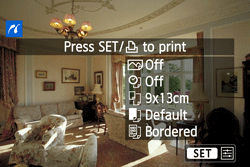 8. The print setting screen will appear.  * Depending on the printer, certain settings such as the date and file number imprinting and cropping may not be selectable. 9. Select [Paper settings], then press <  >. 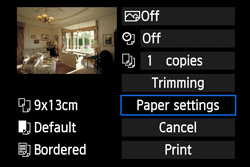 10. The paper settings screen will appear. <Setting the Paper Size> Select the size of the paper loaded in the printer, then press <  >. The paper type screen will appear. <Setting the Paper Type> Select the type of the paper loaded in the printer, then press <  >. <Setting the Page Layout> Select the page layout, then press <  >. The print setting screen will reappear. | Bordered | The print will have white borders along the edges. | | Borderless | The print will have no borders. If your printer cannot print borderless prints, the print will have borders. | Bordered  | The shooting information (*1) will be imprinted on the border on 9x13 cm and larger prints. | | xx-up | Option to print 2, 4, 8, 9, 16, or 20 images on one sheet. | 20-up 
35-up  | 20 or 35 images will be printed as thumbnails on A4 or Letter size paper*(*2)
[20-up  ] will have the shooting information(*1) imprinted. ] will have the shooting information(*1) imprinted. | | Default | The page layout will vary depending on the printer model or its settings. |
*1: From the Exif data, the camera name, lens name, shooting mode, shutter speed, aperture, exposure compensation amount, ISO speed, white balance, etc., will be imprinted.
*2: After ordering the prints with "Digital Print Order Format (DPOF)", it is recommended that you print by following "Direct Printing with DPOF". For details, see the instruction manual supplied with your camera. IMPORTANT If the images aspect ratio is different from the printing papers aspect ratio, the image may be cropped significantly if you print it as a borderless print. If the image is cropped, it may look more grainy on the paper due to the fewer number of pixels.
11. Set the printing effects (image optimization) if necessary. If you do not need to set any printing effects, go to step 12. 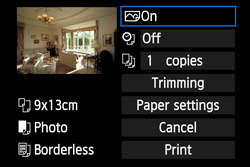 What is displayed on the screen differs depending on the printer. 11-1. Select the option, then press <  >. 11-2. Select the desired printing effect, then press <  >. If the <  > icon is displayed brightly next to <INFO>, you can also adjust the printing effect. For details, refer to the instruction manuals that came with your camera. | Printing Effect | Description |
|---|
 On On | The image will be printed using the printers standard colors. The images Exif data is used to make automatic corrections. |  Off Off | No automatic correction will be applied. |  Vivid Vivid | The image will be printed with higher saturation to produce more vivid blues and greens. |  NR NR | Image noise is reduced before printing. |  B/W B/W | Prints in black-and-white with true blacks. |  Cool tone Cool tone | Prints in black-and-white with cool, bluish blacks. |  Warm tone Warm tone | Prints in black-and-white with warm, yellowish blacks. |  Natural Natural | Prints the image in the actual colors and contrast. No automatic color adjustments are applied. |  Natural M Natural M | The printing characteristics are the same as the "Natural" setting. However, this setting enables finer printing adjustments than with "Natural." |  Default Default | The printing will differ depending on the printer. For details, refer to the printers instruction manual. | |
* When you change the printing effects, changes are reflected in the image displayed on the upper left. Note that the printed image may look slightly different from the displayed image, which is only an approximation. 12. Set the date and file number imprinting if necessary. - If you need to set the date and file number imprinting, select [
 ], then press < ], then press < >. >.
- Select whether to print the date, the file number, or , and then press <
 >. >.
13. Set the number of copies as necessary. - Select [
 ], then press < ], then press < >. >.
- Set the number of copies, then press <
 >. >.
14. Select [Print], then press <  >.  NOTE - The [Default] setting for printing effects and other options are the printers own default settings as set by the printers manufacturer. Refer to the printers instruction manual to find out what the [Default] settings are.
- Depending on the images file size and image-recording quality, it may take some time for the printing to start after you select [Print].
- If image tilt correction is applied, it may take longer to print the image.
- To stop the printing, press <
 > while [Stop] is displayed, then select [OK]. > while [Stop] is displayed, then select [OK]. - If you execute [Clear all camera settings], all the settings will revert to their defaults.
|